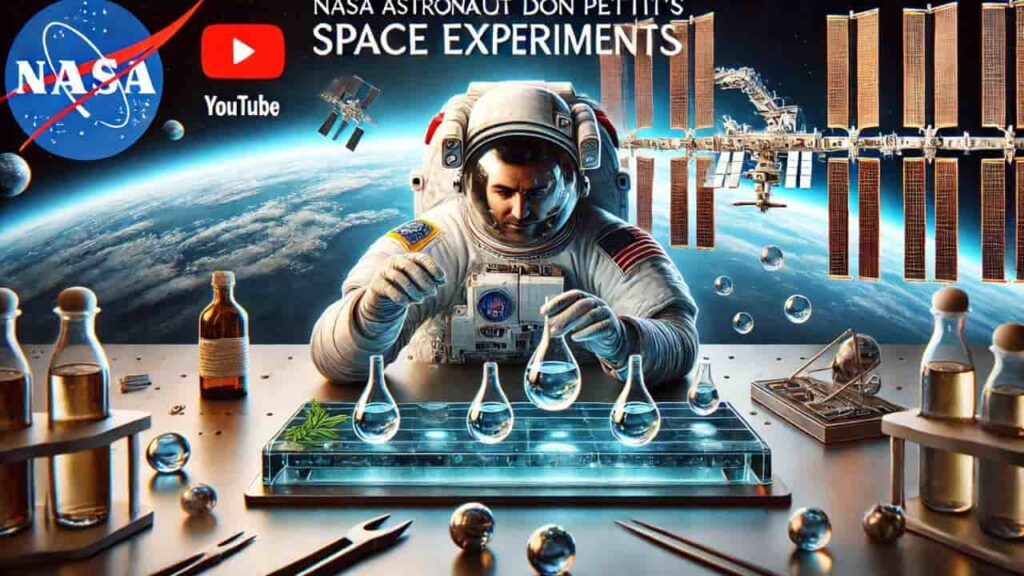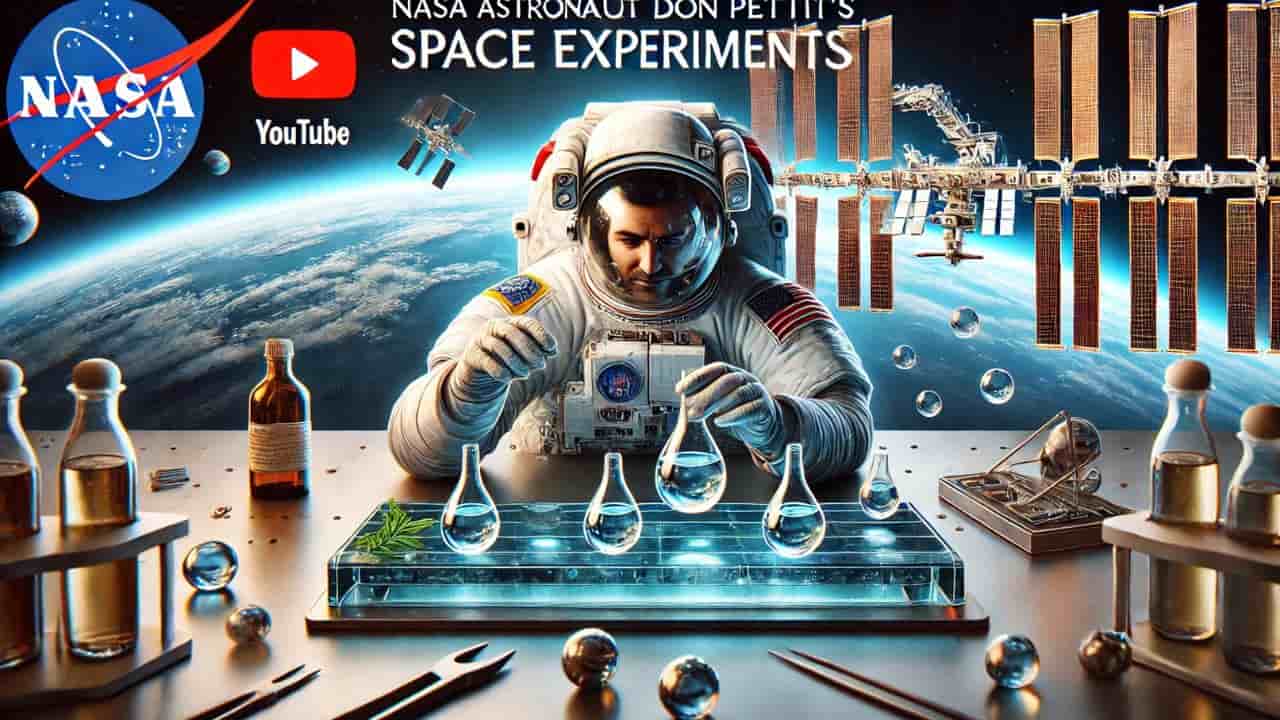NASA astronaut Don Pettit, space experiments, science of opportunity, International Space Station, microgravity experiments, Don Pettit space innovations, planetary formation, Capillary Beverage, freezing water in space, electrostatic orbits, space photography, ISS discoveries
Explore NASA astronaut Don Pettit’s groundbreaking “science of opportunity” experiments aboard the International Space Station, where curiosity and creativity led to remarkable discoveries in microgravity, planetary formation, fluid dynamics, and more.

NASA Astronaut Don Pettit’s Science of Opportunity on Space Station
Science has always been about exploring new frontiers and asking questions no one has thought to ask. For NASA astronaut Don Pettit, these frontiers extend beyond Earth, out into the vast expanse of space aboard the International Space Station (ISS). Pettit’s inventive mind and relentless curiosity have led him to perform experiments during his free time aboard the station—experiments that have resulted in breakthroughs in space science and valuable contributions to humanity’s understanding of the universe. This article delves into Pettit’s unique “science of opportunity” and highlights the key experiments that have expanded the boundaries of knowledge in space exploration.
The Curious Nature of Don Pettit
Don Pettit, a NASA astronaut known for his creativity and passion for science, has participated in multiple missions to the ISS. His inventive nature is well-documented through a variety of personal experiments conducted with minimal materials—often items available aboard the station or even from his own personal belongings. These experiments, performed outside of official mission objectives, have led to valuable discoveries and contributed to the broader understanding of scientific phenomena in microgravity.
In September 2024, Pettit is scheduled to return to the ISS for his fourth spaceflight, accompanied by cosmonauts Alexey Ovchinin and Ivan Vagner. As preparations are underway for this mission, it’s an excellent opportunity to revisit some of Pettit’s previous scientific breakthroughs aboard the ISS, which reflect his innovative spirit and the potential of space as a laboratory for discovery.
Freezing Water in Space: The Ice Experiment
Have you ever noticed how air gets trapped inside ice cubes made in your freezer at home? This everyday phenomenon, caused by gravity forcing air bubbles to accumulate in one area, caught Pettit’s attention during one of his previous space missions. He wondered how water would freeze in the absence of gravity, a condition only possible in space. With access to a -90° Celsius freezer aboard the ISS and some free time, Pettit set out to explore how microgravity affects the freezing process.
Pettit’s ice experiment used polarized light to observe the thin frozen water and compare it with ice formed on Earth. The resulting ice displayed distinct differences from what we typically see in our freezers. By understanding how freezing works in microgravity, Pettit’s experiment provided deeper insights into the physics of phase transitions and heat transfer, areas of interest for scientists studying how liquids and gases behave in space.
The findings of this experiment could have implications for future space missions, particularly those involving life support systems that rely on the management of water and other fluids. In addition, the research contributes to our understanding of fundamental physics in environments that differ dramatically from Earth.
The Space Cup: A Capillary Beverage Innovation
One of the most mundane yet essential tasks—drinking—becomes a challenge in space. On Earth, gravity assists us when we drink liquids, allowing them to flow naturally into our mouths. In microgravity, however, astronauts use sealed bags with straws to consume beverages. Don Pettit, with his problem-solving mindset, decided to tackle this issue and developed the Capillary Beverage, also known as the Space Cup.
Pettit’s invention involved using surface tension, wetting properties, and the unique shape of the cup to simulate the role of gravity, enabling astronauts to drink liquids in a more natural and familiar manner. He used materials such as overhead transparency film to design a prototype that allowed liquids to flow smoothly toward the mouth without relying on a straw.
The Space Cup is not only a practical innovation for astronauts; it also serves as a reminder of how space missions can inspire new technologies and systems that may one day benefit people on Earth. By studying fluid dynamics in space, scientists gain valuable insights into how fluids behave in zero-gravity environments, which can influence the design of spacecraft systems, medical devices, and even everyday products.
Exploring Planetary Formation with Everyday Materials
Pettit’s fascination with planetary formation led him to experiment with everyday materials like table salt, sugar, and coffee. In space, where microgravity conditions allow for unique observations of particle behavior, Pettit sought to understand the early stages of planet formation by investigating how tiny particles aggregate or clump together.
Using plastic bags filled with different particulate mixtures, Pettit observed that shaking the bags caused the particles to clump within seconds due to what appeared to be electrostatic forces. These forces, which may play a role in planetary formation, are not fully understood by scientists. Pettit’s simple yet effective experiment shed light on how particle composition, density, and turbulence interact in the formation of larger bodies in space.
The insights from this experiment are invaluable for researchers studying the origins of planets and other celestial bodies. By recreating and analyzing these processes in a microgravity environment, Pettit’s work has contributed to a broader understanding of the forces at play during the early stages of planetary formation.
Electrostatic Orbits and Charged Water Droplets
Another groundbreaking experiment involved the use of knitting needles and charged water droplets to demonstrate electrostatic orbits in microgravity. Pettit, with his knack for turning simple objects into scientific tools, used knitting needles made from different materials and charged them by rubbing each one with paper. He then released charged water droplets from a Teflon syringe and observed how the droplets orbited the knitting needle in a behavior reminiscent of celestial bodies orbiting a planet.
This experiment was later simulated with atmospheric drag, and the 3D motion of the droplets matched the orbits observed in the ISS experiment. Pettit’s findings were significant, as they could be analogous to the behavior of charged particles in Earth’s magnetic field. This experiment could inform the design of future spacecraft systems, particularly in understanding how charged particles behave in space and how they interact with various surfaces.
The simplicity and elegance of this experiment highlight Pettit’s ability to find meaningful scientific opportunities in everyday objects. His work on electrostatic orbits provides yet another example of how the ISS serves as a unique laboratory for investigating phenomena that are difficult or impossible to observe on Earth.
Capturing the Beauty of Earth and the Cosmos
Beyond his scientific experiments, Don Pettit has also contributed to our understanding of Earth and the cosmos through photography. As an innovative photographer, Pettit used techniques such as time exposure, multiple cameras, and infrared photography to capture breathtaking images of Earth and star trails from the unique vantage point of the ISS.
Pettit’s images of Earth, taken from space, offer valuable data for researchers studying changes in the planet’s landscape and atmosphere. These photos have been used to track environmental changes over time, such as deforestation, urbanization, and the effects of climate change. By providing a visual record of Earth’s transformations, Pettit’s photography contributes to the broader field of Earth science and raises awareness about the importance of protecting our planet.
In addition to their scientific value, Pettit’s images have inspired countless people by showing the beauty and wonder of space exploration. His work helps bridge the gap between the scientific community and the general public, fostering a greater appreciation for human spaceflight and the pursuit of knowledge.
The Legacy of Don Pettit’s Science of Opportunity
Don Pettit’s approach to science aboard the ISS demonstrates the power of curiosity, creativity, and resourcefulness in advancing human knowledge. By taking advantage of the unique conditions of microgravity, Pettit has made significant contributions to fields ranging from fluid dynamics to planetary science, all while using simple materials and tools readily available in space.
His “science of opportunity” exemplifies the idea that some of the greatest discoveries come from tinkering with new concepts and asking unconventional questions. Pettit’s work reminds us that space exploration is not just about achieving mission objectives—it’s about fostering a spirit of innovation and discovery that can benefit humanity in countless ways.
As Pettit prepares for his upcoming mission in September 2024, there is no doubt that his inventive mind will continue to push the boundaries of what is possible in space. His legacy as a scientist, explorer, and inventor will inspire future generations of astronauts to view the ISS not just as a place for conducting planned experiments, but as a laboratory where curiosity can lead to groundbreaking discoveries.
Conclusion
NASA astronaut Don Pettit’s contributions to space science are a testament to the value of creativity and curiosity in the pursuit of knowledge. His experiments aboard the ISS have expanded our understanding of fluid dynamics, planetary formation, and electrostatic forces, all while using everyday materials in innovative ways. Pettit’s work illustrates how the “science of opportunity” can lead to remarkable discoveries, even in the most unexpected circumstances. As he prepares for his next mission, the world eagerly awaits what new insights and inventions he will bring back from the final frontier.
Read More
- NASA Missy Elliott: Hip-Hop Song Beamed to Venus
- SpaceXs New Falcon 9 Booster Successfully Launches 22 Starlink Satellites Boosting Global Connectivity
- NASA Citizen Scientists Discover Hypervelocity Star Zooming Out of the Milky Way
- NASA Issues Warning About 88-ft Airplane-Sized Asteroid Approaching Earth – Key Details Revealed










